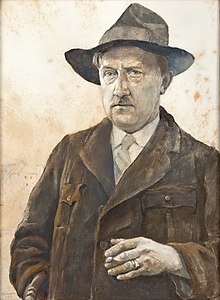Wilhelm Sauter
Wilhelm Sauter (born April 1, 1896 in Bruchsal , † June 27, 1948 in Göppingen ) was a German painter and draftsman .
Life
Wilhelm Sauter was born as the only son of the civil servant clerk Friedrich Sauter. After attending elementary and secondary school, he entered the Heidelberg teacher training college in 1913 with the aim of becoming a drawing teacher. After the outbreak of the First World War , he became a soldier in the 8th Baden Infantry Regiment No. 169 in Lahr in 1915 and was deployed on the Somme from April 1916 , including in the area around Serre . When a grenade hit, he was buried and lost part of his hearing. The experiences at the front later formed the basis of his most famous works.
After a stay in the hospital, he worked at the elementary school in Bruchsal from 1917 . From 1918 to 1920 he studied at the Baden State Art School , among others with Professors Karl Eyth, August Groh , Walter Conz and Friedrich Fehr . Employment at schools in Villingen , Bruchsal, Karlsruhe , Weinheim and Ladenburg followed . At the instigation of Hans Thoma , a first exhibition took place at the Badischer Kunstverein .
Wilhelm Sauter married in the 1920s. One son died of diphtheria at the age of 14 .
The techniques used by Wilhelm Sauter included both drawing and painting as well as etching . In the years 1924 to 1927 he created six drypoint etchings as an illustration for Grimmelshausen's novel Der adventurliche Simplicissimus . In addition, Wilhelm Sauter created numerous portraits and landscapes, as well as depictions of soldiers from the front in different situations.
Sauter's images of soldiers attracted the attention of the National Socialist regime in particular . Although his works by no means glorified the war, the rulers saw in them above all a representation of trials from which the German soldier emerges steeled. To what extent Sauter himself was a staunch National Socialist is unclear; in any case, he knew how to come to terms with the ruling political forces. This was followed by a steep professional rise with participation in numerous art exhibitions, for example the exhibition "Heroic Art" in Berlin in 1935 , the Badische Gaukulturschau in 1937, the Great German Art Exhibitions in the House of German Art in Munich or in 1942 at the Biennale in Venice . At the exhibition German artists and the SS in 1944 in Breslau and then also in Salzburg , his picture “Bundschuh-Hauptmann Joss lost with his farmers from the Kraichgau” was exhibited. The soldier pictures from this period are less gloomy than the earlier works, instead the motif of the heroic soldier emerges more strongly. There were also individual works clearly marked by the National Socialists (for example “ Kampfzeit ”).
His pictures were acquired by the Badisches Army Museum in Karlsruhe , among others , but also by Adolf Hitler and Fritz Todt .
In 1939 Wilhelm Sauter was awarded the Gaukulturpreis .
In 1941 he was appointed professor at the University of Fine Arts in Karlsruhe - the former Baden State Art School, where he had also studied. His activity there lasted until 1945.
Works (selection)
- Dance of Death (1917-1918)
- Trench Post in the Fire (1928)
- Meal Holer (1931)
- In the trench (1932)
- Endless Road (1934)
- The Good Comrade (1934)
- Water Drinker (1936)
- Hero's Shrine (1936)
- The farmer's leader Joß Fritz (1937)
- Battle Time (1937)
- The Baden Grenadiers in the Battle of Cambrai (1938)
- Front soldier (1938)
- Two ways (1939)
- The Eternal Musketeer (1940)
- Advance in the West (1941)
- Western Front 1940 (1941)
- Serre ( Somme ) 1916 (around 1942)
- Crossing on the Upper Rhine (1942)
- Eastern Fighters (1944)
- Buried
- encounter
- The Serre Cross
- lMG (light machine gun)
- Raiding party
- About dawn
- The dead comrade
- Detector
- Endless road
- The victim (destroyed in an air raid in 1942)
- Gretlebrunnen in the stairwell of the Blue Town Hall in Donaueschingen
gallery
The Old Bridge in Heidelberg (1929)
literature
- Fritz Wilkendorf: The war painter Wilhelm Sauter. In: Ekkhart - Yearbook for the Upper Rhine , Volume 24, G. Braun Verlag, Karlsruhe 1943, pp. 26–37
Individual evidence
- ↑ a b c d Meinrad Schaab , Hansmartin Schwarzmaier (ed.) U. a .: Handbook of Baden-Württemberg History . Volume 4: Die Länder since 1918. Edited on behalf of the Commission for Historical Regional Studies in Baden-Württemberg . Klett-Cotta, Stuttgart 2003, ISBN 3-608-91468-4 , p. 214.
- ^ Works by Wilhelm Sauter at the Great German Art Exhibitions 1937-1944
- ↑ List of former professors ( Memento of the original from February 15, 2012 in the Internet Archive ) Info: The archive link was inserted automatically and has not yet been checked. Please check the original and archive link according to the instructions and then remove this notice. on the website of the State Academy of Fine Arts Karlsruhe
- ↑ http://www.bilder-geschichte.de/ns-kunst.htm
- ↑ Exhibition catalog 1940 from the House of German Art in Munich
- ↑ Picture postcards from the House of German Art in Munich
- ↑ Picture postcards from the House of German Art in Munich
- ↑ Stefan Limberger-Andris: A fountain that makes you foolish in: Schwarzwälder Bote , January 5, 2013
| personal data | |
|---|---|
| SURNAME | Sauter, Wilhelm |
| BRIEF DESCRIPTION | German painter and draftsman |
| DATE OF BIRTH | April 1, 1896 |
| PLACE OF BIRTH | Bruchsal |
| DATE OF DEATH | June 27, 1948 |
| Place of death | Goeppingen |








